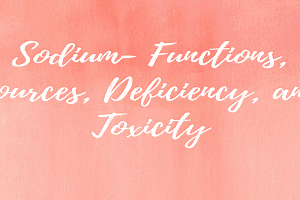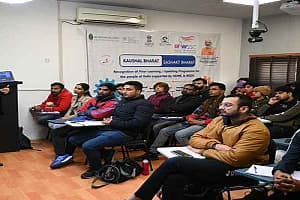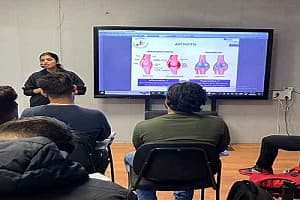Sodium- Functions, Sources, Deficiency, and Toxicity
Created On: Mar 23, 2021

*Director, Classic Fitness Academy, New Delhi
**Technical Writer, Classic Fitness Academy, New Delhi
Introduction
Sodium — often known as table salt (40% sodium and 60% chloride) and found in nearly everything you eat and drink. It occurs naturally in many foods, may be added to others during the manufacturing process and many times used as a flavoring agent, stabilizer, and preservative at home and restaurants. Nowadays, sodium is linked with many lifestyle diseases such as high blood pressure which damages the arteries and increases the risk of other heart diseases and kidney diseases. Hence there are guidelines for limiting sodium intake.
Recommended Daily Allowance
Despite its continued criticism, a minimum of 500mg/day of sodium is necessary to perform vital functions of the body. However, its RDA value is a maximum of 2300 mg/day (2.3 grams; equals 1 tablespoon) for the general population, and for pregnant/old age people >1500, mg/day (1.5 grams) is recommended.
Functions
• To conduct nerve impulses: During the resting state, the sodium-potassium pump maintains a difference in charge across the cell membrane of the neuron, when signals come across the membrane, the sodium channel opens and they enter into the cell.
• Contract/relax muscles: To contract a muscle fiber, sodium rapidly flows into the cell, and simultaneously potassium comes out of the cell. These steps are reversed when a muscle relaxes means sodium moves out of the cell, and potassium back into the cells.
• Maintain a proper balance of water/minerals: It is one of the body's electrolytes and an important part of a very complex, fluid balance process. Our body keeps a record for loss of body water and the hypothalamus senses the sodium and water concentration in extracellular fluids and accordingly restores them. Most of the body's sodium resides in blood and the fluid that surrounds the cells.

Food source:
Sodium is not such a nutrient that we look at food sources. Its minimum amount which is required to perform vital functions is completed from the daily diet as it contains enough salt. Sodium is negligible in dairy products, fruits, vegetables, unprocessed foods and high in processed foods, junk foods, and processed drinks.

Deficiency
Sodium deficiency leads to ‘Hyponatremia', a condition where sodium level drops in the blood which can be due to excessive vomiting, diarrhea, and excess sweating.
Toxicity
If sodium concentration rises in the blood it causes 'Hypernatremia’, a condition where sodium accumulates in blood than the normal level which can lead to high blood pressure, heart disease, stroke, kidney damage, seizures, coma, intense thirst, and death.
Guidelines for Cutting Down on Salt
• Avoid salty foods in diets or choose low sodium foods. When reading food labels, low sodium is defined as 140 mg of sodium per serving.
• Reduce the amount of salt used in cooking.
• Season foods with spices, herbs, lemon, garlic, ginger, vinegar, and pepper.
• Read ingredient labels if foods are with 400 mg or more of sodium then they are high in sodium.
• Eat more home-cooked meals; they are naturally lower in sodium than packaged foods.
References:
(1) Sung Kyu Ha (2014). Dietary Salt Intake and Hypertension. Electrolytes and Blood Pressure 12(1): 7–18.
(2) Strazzullo P (2014). Sodium. Advances in Nutrition 5(2): 188–190.
(3) Seth WH and Johnson AK (2015). The biopsychology of salt hunger and sodium deficiency. European Journal of Physiology 467(3): 445–456.
(4) He FJ, Li J, Macgregor GA (2013). Effect of longer-term modest salt reduction on blood pressure. Cochrane Database of System Reviews 30(4).
(5) Cutler JA, Follmann D, Allender PS (1997). Randomized trials of sodium reduction: an overview. American Journal of Clinical Nutrition 65(2):643-651.
(6) Rust P, Ekmekcioglu C (2017) Impact of Salt Intake on the Pathogenesis and Treatment of Hypertension. Advances in Experimental Medicine and Biology 956:61-84.
Sodium — often known as table salt (40% sodium and 60% chloride) and found in nearly everything you eat and drink. It occurs naturally in many foods, may be added to others during the manufacturing process and many times used as a flavoring agent, stabilizer, and preservative at home and restaurants. Nowadays, sodium is linked with many lifestyle diseases such as high blood pressure which damages the arteries and increases the risk of other heart diseases and kidney diseases. Hence there are guidelines for limiting sodium intake.
Recommended Daily Allowance
Despite its continued criticism, a minimum of 500mg/day of sodium is necessary to perform vital functions of the body. However, its RDA value is a maximum of 2300 mg/day (2.3 grams; equals 1 tablespoon) for the general population, and for pregnant/old age people >1500, mg/day (1.5 grams) is recommended.
Functions
• To conduct nerve impulses: During the resting state, the sodium-potassium pump maintains a difference in charge across the cell membrane of the neuron, when signals come across the membrane, the sodium channel opens and they enter into the cell.
• Contract/relax muscles: To contract a muscle fiber, sodium rapidly flows into the cell, and simultaneously potassium comes out of the cell. These steps are reversed when a muscle relaxes means sodium moves out of the cell, and potassium back into the cells.
• Maintain a proper balance of water/minerals: It is one of the body's electrolytes and an important part of a very complex, fluid balance process. Our body keeps a record for loss of body water and the hypothalamus senses the sodium and water concentration in extracellular fluids and accordingly restores them. Most of the body's sodium resides in blood and the fluid that surrounds the cells.

Food source:
Sodium is not such a nutrient that we look at food sources. Its minimum amount which is required to perform vital functions is completed from the daily diet as it contains enough salt. Sodium is negligible in dairy products, fruits, vegetables, unprocessed foods and high in processed foods, junk foods, and processed drinks.

Deficiency
Sodium deficiency leads to ‘Hyponatremia', a condition where sodium level drops in the blood which can be due to excessive vomiting, diarrhea, and excess sweating.
Toxicity
If sodium concentration rises in the blood it causes 'Hypernatremia’, a condition where sodium accumulates in blood than the normal level which can lead to high blood pressure, heart disease, stroke, kidney damage, seizures, coma, intense thirst, and death.
Guidelines for Cutting Down on Salt
• Avoid salty foods in diets or choose low sodium foods. When reading food labels, low sodium is defined as 140 mg of sodium per serving.
• Reduce the amount of salt used in cooking.
• Season foods with spices, herbs, lemon, garlic, ginger, vinegar, and pepper.
• Read ingredient labels if foods are with 400 mg or more of sodium then they are high in sodium.
• Eat more home-cooked meals; they are naturally lower in sodium than packaged foods.
References:
(1) Sung Kyu Ha (2014). Dietary Salt Intake and Hypertension. Electrolytes and Blood Pressure 12(1): 7–18.
(2) Strazzullo P (2014). Sodium. Advances in Nutrition 5(2): 188–190.
(3) Seth WH and Johnson AK (2015). The biopsychology of salt hunger and sodium deficiency. European Journal of Physiology 467(3): 445–456.
(4) He FJ, Li J, Macgregor GA (2013). Effect of longer-term modest salt reduction on blood pressure. Cochrane Database of System Reviews 30(4).
(5) Cutler JA, Follmann D, Allender PS (1997). Randomized trials of sodium reduction: an overview. American Journal of Clinical Nutrition 65(2):643-651.
(6) Rust P, Ekmekcioglu C (2017) Impact of Salt Intake on the Pathogenesis and Treatment of Hypertension. Advances in Experimental Medicine and Biology 956:61-84.






